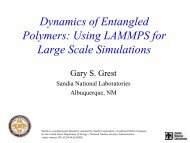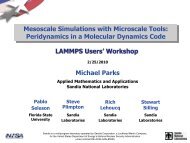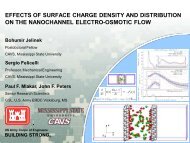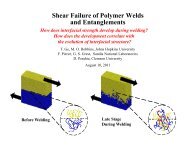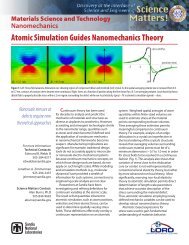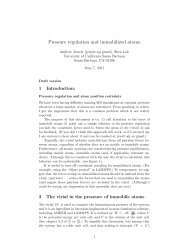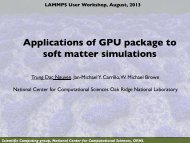Simulation of Entangled Polymers with Dissipative ... - Lammps
Simulation of Entangled Polymers with Dissipative ... - Lammps
Simulation of Entangled Polymers with Dissipative ... - Lammps
You also want an ePaper? Increase the reach of your titles
YUMPU automatically turns print PDFs into web optimized ePapers that Google loves.
<strong>Entangled</strong> Polymer Melts <strong>with</strong> <strong>Dissipative</strong> Particle<br />
Dynamics<br />
Timothy Sirk, Yelena Sliozberg, John Brennan,<br />
and Jan Andzelm<br />
Army Research Laboratory<br />
August 11, 2011
Background<br />
Atomistic<br />
K-G<br />
Hard atoms<br />
t d ~N 3.5<br />
t~N 3*(1/2)<br />
x R<br />
R g<br />
Reptation<br />
DPD<br />
Hard beads<br />
Rouse<br />
S<strong>of</strong>t Beads<br />
DN<br />
How to prevent chain crossing, and<br />
still be fast?<br />
…apply force between bonds<br />
2N e<br />
Kremer-Grest<br />
10 5 1/s<br />
250,000 beads<br />
DPD/SRP<br />
10 5 1/s<br />
40,000 beads<br />
Yelena Sliozberg, unpublished
<strong>Dissipative</strong> Particle Dynamics<br />
F<br />
F<br />
F<br />
i<br />
C<br />
ij<br />
D<br />
ij<br />
<br />
ji<br />
<br />
a<br />
<br />
<br />
F<br />
ij<br />
C<br />
ij<br />
<br />
F<br />
D<br />
ij<br />
F<br />
R<br />
ij<br />
F<br />
SRP<br />
ij<br />
1<br />
r<br />
ˆ<br />
r<br />
r<br />
<br />
ij<br />
/rc<br />
r ij<br />
<br />
ij<br />
c<br />
0 rij<br />
rc<br />
<br />
D<br />
r<br />
r<br />
ˆ v rˆ<br />
ij<br />
ij<br />
ij<br />
ij<br />
F<br />
H<br />
ij<br />
F<br />
A<br />
ij<br />
<br />
Total Force<br />
DPD<br />
<br />
R R ij<br />
F ˆ<br />
ij<br />
r<br />
ij<br />
Groot and Warren, J.<br />
Δt<br />
Chem. Phys. 1997<br />
<br />
D<br />
2<br />
<br />
F<br />
F<br />
E<br />
SRP<br />
ij<br />
H<br />
ij<br />
ijk<br />
r<br />
<br />
R<br />
<br />
2k<br />
T<br />
B<br />
<br />
r<br />
E<br />
<br />
aij<br />
<br />
0<br />
K(r<br />
r ) rˆ<br />
2<br />
1<br />
d<br />
/<br />
ˆ<br />
d<br />
d<br />
<br />
ij<br />
d<br />
c<br />
d ij<br />
<br />
ij<br />
c<br />
d<br />
d <br />
0<br />
K cos( )<br />
ij<br />
ij<br />
c<br />
SRP<br />
Segmental Repulsive Potential<br />
Goujon et. al, J. Chem. Phys.<br />
129, 034902 (2008)<br />
Bond & Angle<br />
Current SRP<br />
•minimum distance between two bonds<br />
•distribute force unevenly between atoms<br />
•slow, sometimes overshoots d ij<br />
mSRP (new)<br />
•midpoint distance between bonds<br />
Requires new<br />
•distribute force evenly<br />
parameters for SRP,<br />
•faster, accurate<br />
angle potentials<br />
Goujon [1]<br />
0F<br />
mSRP ½F<br />
F<br />
½ F<br />
d d ij<br />
ij<br />
-¾ F -¼ F -½ F -½ F<br />
58 mult/add, 2 div, 2 if 18 mult/add<br />
DPD + SRP + Bond + Angles<br />
SRP implemented in LAMMPS<br />
•communicate ‘ghost bonds’ <strong>with</strong> forward_pair_comm()<br />
•build a bond neighbor list<br />
•newton<br />
bond <strong>of</strong>f, apply force to local atoms<br />
d kl =P k +t k R k ‐P l ‐t l R l<br />
d(d kl )/d(R k )=d(d kl )/d(R l )=0<br />
d kl =P k ‐P l<br />
1. J. Chem. Phys. 129, 034902, 2008<br />
2. J. Chem. Phys. 114 (15) p6937, 1997
Parameterization: Chain Crossings<br />
d ij<br />
DPD <strong>with</strong> Goujon SRP:<br />
Few chain crossings, large energy contribution<br />
DPD <strong>with</strong>out SRP: Chains cross freely<br />
F<br />
<br />
ij<br />
a ij<br />
d<br />
1<br />
<br />
d<br />
ij<br />
c<br />
<br />
<br />
<br />
Vary potential<br />
parameters: a ij , d c<br />
Increasing d c<br />
Count bond<br />
crossing<br />
Check<br />
thermodynamics<br />
Choose a ij , d c<br />
Test system: 78 chains <strong>of</strong> N=30, 2*10 6 timesteps
Thermodynamic Properties<br />
Prevent bond crossings and minimize the<br />
effect <strong>of</strong> SRP<br />
Midpoint Distance<br />
Want low P, PE contributions, and few<br />
bond crossings -> choose a=100, r=0.8<br />
DPD <strong>with</strong> Goujon SRP:<br />
Large PE and pressure<br />
Decreasing d cut<br />
• Small pressure increase over DPD<br />
• Thermostat stable at low temp<br />
•Any<br />
γ>4.5<br />
Minimum Distance (Goujon<br />
et. al)<br />
• Larger PE and pressure<br />
• Thermostat struggles <strong>with</strong> low temp<br />
• Restricted to γ~50 for T=1.0<br />
DPD <strong>with</strong>out SRP:<br />
Lower limit<br />
Decreasing d cut
Angle potential and chain<br />
structure<br />
Problem<br />
•Neighboring bonds do not interact<br />
•Favorable for chain to “fold”<br />
•Not good for structure<br />
•Quantify by characteristic ratio, C n<br />
Solution<br />
•Add angular potential to maintain<br />
structure<br />
•Optimize<br />
K using C n<br />
•Too weak = poor structure<br />
•Too much = polymer is stiff<br />
θ<br />
E K[ 1cos(<br />
)]<br />
K=2.0 leads has C n close to fully<br />
flexible (C n =1.0)<br />
Vary parameter: K<br />
Check chain<br />
structure<br />
Choose K<br />
Goujon et al. is less than regular<br />
DPD chain due to “kinks”<br />
R<br />
C n = /nl 2
Diffusion<br />
Equilibration<br />
D vs. 1/L<br />
1. Box Size: depends your needs<br />
1. Structure<br />
2. Stress/Strain<br />
3. Diffusion<br />
2. Time: not straightforward<br />
1. MSD g1 = MSD g3 won’t happen for long chains<br />
2. At least move a radius <strong>of</strong> gyration<br />
3. Better to wait for 0.90*d(g 1 )/dt = d(g 3 )/dt<br />
3. Shortcut: measure characteristic ratio, prebuild the<br />
equilibrium structure<br />
<br />
inner monomers<br />
center <strong>of</strong> mass (COM)<br />
inner monomers wrt COM <strong>of</strong> chain<br />
Analytical Correction<br />
Chain Length and Entanglements<br />
1. Identify entanglements <strong>with</strong> diffusion<br />
• onset <strong>of</strong> entangled behavior<br />
• chain length for one entanglement<br />
2. Check mechanical behavior <strong>of</strong> entangled chains<br />
mSRP<br />
Goujon SRP<br />
Dynamics <strong>of</strong> chains from<br />
DPD+ entanglements<br />
reaches reptation limit !<br />
To calculate chain diffusion (DN):<br />
Equilibrate until monomers move<br />
together <strong>with</strong> chains
Mechanical Behavior<br />
• tensile test – a fundamental mechanical test<br />
• create stress by deforming simulation box<br />
• compute normal stress as the box is deformed<br />
Unentangled chains<br />
• short DPD chains <strong>with</strong> mSRP<br />
• short/long standard DPD<br />
• less relative motion when stress is applied<br />
<strong>Entangled</strong> chains<br />
• long DPD chains <strong>with</strong> mSRP<br />
• entanglements resist relative movement <strong>of</strong> chains<br />
• relax more slowly than short chains<br />
*<br />
Long, DPD+mSRP<br />
Short, DPD+mSRP<br />
Long and short, DPD
Timothy Sirk<br />
Army Research Laboratory<br />
tim.sirk@us.army.mil



